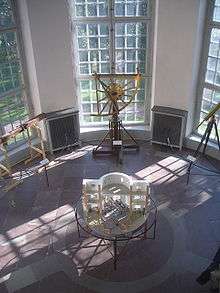Stockholm Observatory

The Stockholm Observatory (Swedish: Stockholms observatorium) is an astronomical institution in Stockholm, Sweden, founded in the 18th century and today part of Stockholm University. Its history is connected to two actual historical observatory complexes in the Stockholm area.
The first observatory was established by the Royal Swedish Academy of Sciences on the initiative of its secretary Per Elvius. Construction, according to designs by the architect Carl Hårleman, begun in 1748 and the building was completed in 1753. It is situated on a hill in a park nowadays named Observatorielunden. The first head of the observatory was Pehr Wilhelm Wargentin. Later heads of the observatory include Hugo Gyldén and Bertil Lindblad. This 18th-century observatory today functions as a museum. 59°20′30″N 18°03′17″E / 59.34167°N 18.05472°E
A newer observatory was built in Saltsjöbaden outside Stockholm and completed in 1931 (the architect this time being Axel Anderberg). 59°16′18″N 18°18′30″E / 59.27167°N 18.30833°E More recent astronomical observations, however, are almost exclusively being done in observatories outside Sweden and closer to the equator.

The research institute was transferred from the Academy to the university in 1973 and is since 2001 housed in the AlbaNova University Centre.
The young Hjalmar Branting, later the first social democratic prime minister of Sweden, was employed as a mathematics assistant at the Stockholm Observatory 1879-1880 and 1882-1883.
External links
- Observatory Museum (The Old Stockholm Observatory)
- Stockholm Observatory, official website of new observatory